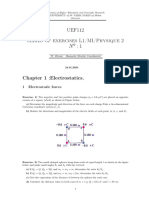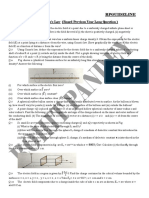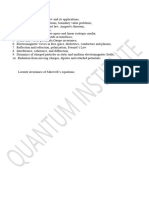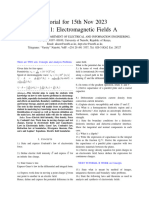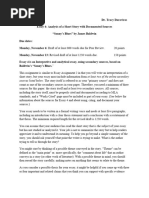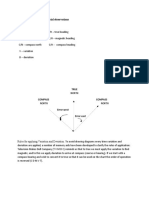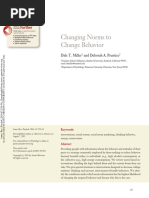0 ratings0% found this document useful (0 votes)
86 viewsElectromagnetic Field & Its Applications (EE30012)
Electromagnetic Field & Its Applications (EE30012)
Uploaded by
rohan9643This document is an exam for a course on electromagnetic fields and applications. It contains 5 questions testing various concepts:
1) Derive expressions for the divergence of a vector in generalized coordinates and for the electric field due to a uniformly charged circular disk.
2) Derive expressions for the electric field and induced surface charge density due to a point charge near a conducting sphere.
3) Establish boundary conditions for electric fields at dielectric-dielectric and dielectric-conductor interfaces. Calculate fields given an interface and field in a dielectric.
4) Obtain equipotential loci for parallel line charges and use this to derive a formula for parallel conductor capacitance.
5) Calculate the energy of a uniformly
Copyright:
© All Rights Reserved
Available Formats
Download as PDF, TXT or read online from Scribd
Electromagnetic Field & Its Applications (EE30012)
Electromagnetic Field & Its Applications (EE30012)
Uploaded by
rohan96430 ratings0% found this document useful (0 votes)
86 views1 pageThis document is an exam for a course on electromagnetic fields and applications. It contains 5 questions testing various concepts:
1) Derive expressions for the divergence of a vector in generalized coordinates and for the electric field due to a uniformly charged circular disk.
2) Derive expressions for the electric field and induced surface charge density due to a point charge near a conducting sphere.
3) Establish boundary conditions for electric fields at dielectric-dielectric and dielectric-conductor interfaces. Calculate fields given an interface and field in a dielectric.
4) Obtain equipotential loci for parallel line charges and use this to derive a formula for parallel conductor capacitance.
5) Calculate the energy of a uniformly
Original Description:
questions
Copyright
© © All Rights Reserved
Available Formats
PDF, TXT or read online from Scribd
Share this document
Did you find this document useful?
Is this content inappropriate?
This document is an exam for a course on electromagnetic fields and applications. It contains 5 questions testing various concepts:
1) Derive expressions for the divergence of a vector in generalized coordinates and for the electric field due to a uniformly charged circular disk.
2) Derive expressions for the electric field and induced surface charge density due to a point charge near a conducting sphere.
3) Establish boundary conditions for electric fields at dielectric-dielectric and dielectric-conductor interfaces. Calculate fields given an interface and field in a dielectric.
4) Obtain equipotential loci for parallel line charges and use this to derive a formula for parallel conductor capacitance.
5) Calculate the energy of a uniformly
Copyright:
© All Rights Reserved
Available Formats
Download as PDF, TXT or read online from Scribd
Download as pdf or txt
0 ratings0% found this document useful (0 votes)
86 views1 pageElectromagnetic Field & Its Applications (EE30012)
Electromagnetic Field & Its Applications (EE30012)
Uploaded by
rohan9643This document is an exam for a course on electromagnetic fields and applications. It contains 5 questions testing various concepts:
1) Derive expressions for the divergence of a vector in generalized coordinates and for the electric field due to a uniformly charged circular disk.
2) Derive expressions for the electric field and induced surface charge density due to a point charge near a conducting sphere.
3) Establish boundary conditions for electric fields at dielectric-dielectric and dielectric-conductor interfaces. Calculate fields given an interface and field in a dielectric.
4) Obtain equipotential loci for parallel line charges and use this to derive a formula for parallel conductor capacitance.
5) Calculate the energy of a uniformly
Copyright:
© All Rights Reserved
Available Formats
Download as PDF, TXT or read online from Scribd
Download as pdf or txt
You are on page 1of 1
- ---~ - ~ - - - - - - ' - -
Department of Electrical Engineering
Indian Institute of Technology, Kharagpur
Electromagnetic Field & its Applications (EE30012) Date: 17th Feb, 2012 AN
3rd & 4th Year EE 41 students
Time: 2 hours. Spring Mid Semester Exam. 2011-2012 FUll Marks: 100
Instructions: Attempt All questions. Intermediate calculation steps and derivation steps must be shown.
1. (a)
(b)
Derive an expression for the divergence of a vector A in generalized orthogonal coordinate system denoted
by axes u
1
, u
2
& u
3
and elemental distances h
1
du1, h2 du2 and h3 du3 from the fundamental definition
of \l X [10]
A thin circular disk of radius a has a uniform charge density +a- C/m
2
spread over it. (i) Derive an
expression for the electric field E at the point P as detailed in Fig.1; (ii) using the result obtained in
(i), derive expression for E at P if the plate were infinite in extent along all the direction and having
same charge density +a- C/m
2
; (iii) Verify your result obtained in (ii) by applying Gauss theorem. [10]
Figure 1: Figure for Q 1 (b). Figure 2: Figure for Q 2(a).
2. (a) A point charge + q is situated in front of a grounded conducting sphere of radius a in free space as
shown in Fig.2. (i) Derive an expression for the electrostatic field Eat a point P(r, e, ). (ii) Also derive
an expression for induced surface charge density a- on the surface of the sphere as a function of e. [12]
(b) Show that in a charge free region, '\1
2
v = 0, where v is an electrostatic potential function. State and
prove uniqueness theorem in relation to the equation '\1
2
v = 0. [4 + 4]
3. (a) Establish the electro-static field boundary conditions at the interface of (i) dielectric-dielectric mediums
and (ii) dielectric-conducting mediums. [10]
(b) The equation of the interface surface between a dielectric material and free space is 3x + 2y + z = 12 m.
The dielectric medium with Erl = 3 is present towards the origin side of the interface. The value of the
electric field in the dielectric and at the interface is El = 2 i(x; + 5 az v /m. Calculate the electric field
E
2
in the free space and at the interface. [10]
4. (a) Two infinitely long, parallel line charge distributions with densities+.-\ C/m and -,\ C/m exist in free
space with separation 2h between them. In terms of rectangular coordinate system, obtain the locus of
equi-potentials and neatly sketch a few of them.
Extend the result as obtained, to find out an expression for capacitance between two parallel conductors
each of diameter d and separated by a distance (center to center) D. [7 + 7]
(b) An electric field
E =
20
2
(-sin
2
Bar +sin2Bao) V/m
Eor
exists in space, find the total charge present within the volume: 1 < r < 2, 0 < e < 7r /2, 0 < z < 1 . [6]
5. (a) A spherical cloud ofradius a= 1.2 Km has uniform volume charge density of p = 10.5 nC/m
3
. Calculate
the total energy associated with the cloud. Derive any formula you use. [6 + 7]
(b) In a region the electric field is given by : E = 20 r z cos ear - 10 r z s i ~ e ao + 10 r
2
cos (} iiz v /m.
Calculate the amount of work done in moving a+ 1 J-LC charge (i) from A(0,0,1) to B(2,0,1); (ii) from
C(2, i 1) to D (2, i 3). [7]
Useful constants: J-Lo = 47r X w-
7
H/m Eo = 8.854 X w-
12
F /m
**********
1
You might also like
- Model Question Paper Engineering Electromagnetics (Em) - 1Document3 pagesModel Question Paper Engineering Electromagnetics (Em) - 1Rahul ThumarNo ratings yet
- John Deere Leadership CompitenciesDocument9 pagesJohn Deere Leadership CompitenciesKarishma KoulNo ratings yet
- Aissce Asngmt CH - 01Document5 pagesAissce Asngmt CH - 016pqq745bq2No ratings yet
- Exam 2002Document7 pagesExam 2002ShootingStarPhotonsNo ratings yet
- Continuous Charge DistributionsDocument24 pagesContinuous Charge DistributionsAsh KaiNo ratings yet
- Ch 1, Electrostatics Wks 3Document2 pagesCh 1, Electrostatics Wks 3majumdarsreoshi28No ratings yet
- Electric and Magnetic FieldsDocument2 pagesElectric and Magnetic FieldsShootingStarPhotonsNo ratings yet
- Tutorial 2Document2 pagesTutorial 2Anwesha NeogNo ratings yet
- Assignments of Physics II - PH1026 - Chapter 22-Week 2Document2 pagesAssignments of Physics II - PH1026 - Chapter 22-Week 2duongne2606No ratings yet
- Emf Gate QuestionsDocument6 pagesEmf Gate QuestionsvijaNo ratings yet
- Kendriya Vidyalaya No2, Afs Kalaikunda Class 12A Physics Worksheet 1 (Chapter 1)Document2 pagesKendriya Vidyalaya No2, Afs Kalaikunda Class 12A Physics Worksheet 1 (Chapter 1)D I N E S H K U M A R S A H UNo ratings yet
- Class Xii PT SUBJECTIVE 2021Document2 pagesClass Xii PT SUBJECTIVE 2021gojo satoruNo ratings yet
- Electromagnetics Assignment Ee /ec: 1.vector Calculas, Coordinate SystemsDocument6 pagesElectromagnetics Assignment Ee /ec: 1.vector Calculas, Coordinate SystemsShubham GoyalNo ratings yet
- CH 23 FDocument24 pagesCH 23 FSaBarney StinsonNo ratings yet
- PYQ Advanced Electrostatics c-1Document18 pagesPYQ Advanced Electrostatics c-1Gagan NandNo ratings yet
- Exam 2003 AnswersDocument10 pagesExam 2003 AnswersShootingStarPhotonsNo ratings yet
- Physics Assignement Summer Vacations Class XiiDocument23 pagesPhysics Assignement Summer Vacations Class Xiiarycool.vermaNo ratings yet
- Physics Imp.. Que.. Chap. 1Document9 pagesPhysics Imp.. Que.. Chap. 1dkurmi282No ratings yet
- Tutorial 3:: ElectrostaticsDocument3 pagesTutorial 3:: ElectrostaticsoscarNo ratings yet
- Gauss Theorem - WORKSHEET - 17869718 - 2024 - 03 - 03 - 15 - 46Document7 pagesGauss Theorem - WORKSHEET - 17869718 - 2024 - 03 - 03 - 15 - 46parasbhardwaj52159No ratings yet
- Master Tutorial I EmwDocument1 pageMaster Tutorial I EmwmudenurrumanNo ratings yet
- Serie1 Phys2 20124 and SolutionsDocument12 pagesSerie1 Phys2 20124 and Solutionsannis LoaiNo ratings yet
- Chapter 1 - Imp 2,3,5 Mark QuestionsDocument4 pagesChapter 1 - Imp 2,3,5 Mark QuestionsaathmikaramanathanNo ratings yet
- 12PhysicsHHWDocument6 pages12PhysicsHHWnfinityp671No ratings yet
- Review Questions For I Mid Term ExaminationDocument2 pagesReview Questions For I Mid Term Examinationeesaikumar039No ratings yet
- Adobe Scan 12 Mar 2024Document7 pagesAdobe Scan 12 Mar 2024yash.mohapatra01No ratings yet
- Phy DOC-20240417-WA0011.Document9 pagesPhy DOC-20240417-WA0011.neeharika.maringantiNo ratings yet
- Electric Charge Pyq 3Document2 pagesElectric Charge Pyq 3mrdeadshot0987No ratings yet
- DDP 4 Gauss's LawDocument2 pagesDDP 4 Gauss's LawAbhishek KushwahaNo ratings yet
- Final 2018Document3 pagesFinal 2018Ashraf WaleedNo ratings yet
- ED Test 1 ProfDocument9 pagesED Test 1 Profmandeep singhNo ratings yet
- Chap 01-02Document3 pagesChap 01-02Ashesh DasNo ratings yet
- ELECTRIC FLUXDocument5 pagesELECTRIC FLUXnn6iefc61No ratings yet
- Fichen1 Chapitre2-EnDocument5 pagesFichen1 Chapitre2-EnDimitri Valdes TchuindjangNo ratings yet
- Tutorial EMDocument3 pagesTutorial EMMaheshree GohilNo ratings yet
- Electrostatics Objective BitsDocument3 pagesElectrostatics Objective Bitsganesh4u_p100% (1)
- Pyqs Xii Physics c1Document6 pagesPyqs Xii Physics c1Ashok Kumar DwivediNo ratings yet
- Mahavir Swami College of Engineering and Technology: Question BankDocument2 pagesMahavir Swami College of Engineering and Technology: Question BankNana's LysosomeNo ratings yet
- 12 wt1 24 Set Bfinal - Copy1Document4 pages12 wt1 24 Set Bfinal - Copy1Richa WasonNo ratings yet
- Jntu Kak 2 2 Ece Emtl Set 1Document15 pagesJntu Kak 2 2 Ece Emtl Set 1himeshemraanNo ratings yet
- ED Test 3 ProfDocument6 pagesED Test 3 Profmandeep singhNo ratings yet
- Science Assignment Chapter-1-1Document4 pagesScience Assignment Chapter-1-1sunilk24423No ratings yet
- PYQ ElectrostaticDocument12 pagesPYQ Electrostaticsaideba44100% (1)
- PYQs Last 15 YearsDocument96 pagesPYQs Last 15 Yearsamanrawatg19No ratings yet
- 2 Electrostaic Work SheetDocument1 page2 Electrostaic Work Sheetnebauzumaki111No ratings yet
- 8417QUESTIONS BANK FOR 12 - 22-23 - FINAL - MODIFIED - 20 PagesDocument20 pages8417QUESTIONS BANK FOR 12 - 22-23 - FINAL - MODIFIED - 20 PagesAkshat Parmar. 11 cNo ratings yet
- _10508Document4 pages_10508Harini BalasubramaniNo ratings yet
- Ch22 SSM-1Document31 pagesCh22 SSM-1alyxs_1No ratings yet
- ExamplesDocument14 pagesExamplesvibish017No ratings yet
- Question Bank EMT-1Document3 pagesQuestion Bank EMT-1Sabarishh Xl A1No ratings yet
- Main Tutorial EMF A Nov 2024Document3 pagesMain Tutorial EMF A Nov 2024111markwaweruNo ratings yet
- EMF Exam2017Document8 pagesEMF Exam2017zcaptNo ratings yet
- EMT 2 Marks and 16 Marks-Question BankDocument30 pagesEMT 2 Marks and 16 Marks-Question BankBright Tendai ChingwenaNo ratings yet
- Em WavesDocument9 pagesEm WavesAyush shuklaNo ratings yet
- Electric and Magnetic FieldsDocument1 pageElectric and Magnetic FieldsShootingStarPhotonsNo ratings yet
- PHY 361 Exam - 2023Document4 pagesPHY 361 Exam - 2023Advocate MataleNo ratings yet
- Holiday Homework - 12th 23-24Document5 pagesHoliday Homework - 12th 23-24Anmol SharmaNo ratings yet
- Fee 351: Electromagnetic Fields: DATE: 23 FEBRUARY2021Document3 pagesFee 351: Electromagnetic Fields: DATE: 23 FEBRUARY2021Peter JumreNo ratings yet
- Electron Beam-Specimen Interactions and Simulation Methods in MicroscopyFrom EverandElectron Beam-Specimen Interactions and Simulation Methods in MicroscopyNo ratings yet
- Problems in Quantum Mechanics: Third EditionFrom EverandProblems in Quantum Mechanics: Third EditionRating: 3 out of 5 stars3/5 (2)
- PointersDocument23 pagesPointersMuqadas HussainNo ratings yet
- 1 s2.0 S0045794905000805 Main PDFDocument10 pages1 s2.0 S0045794905000805 Main PDFCandra ColivinnNo ratings yet
- Ese 2014Document33 pagesEse 2014Rahul SharmaNo ratings yet
- ANOVA Test - Definition, Types, ExamplesDocument8 pagesANOVA Test - Definition, Types, Examplesbluebird1969No ratings yet
- The Complete Guide For New ManagersDocument28 pagesThe Complete Guide For New ManagersDahab Masr- YouTube100% (4)
- Kliping Bhs InggrisDocument16 pagesKliping Bhs InggrisGabriel PontororingNo ratings yet
- Elon MuskDocument12 pagesElon Muskaroob598No ratings yet
- Operating SystemDocument17 pagesOperating SystemPardeep Kumar Sharma SharmaNo ratings yet
- (Developments in Plant Pathology 3) Bradley D. Jones, Stanley Falkow (Auth.), C. I. Kado, J. H. Crosa (Eds.) - Molecular Mechanisms of Bacterial Virulence-Springer Netherlands (1994)Document675 pages(Developments in Plant Pathology 3) Bradley D. Jones, Stanley Falkow (Auth.), C. I. Kado, J. H. Crosa (Eds.) - Molecular Mechanisms of Bacterial Virulence-Springer Netherlands (1994)Pandiya RajanNo ratings yet
- 2019 Mav Exam 2 SolutionsDocument24 pages2019 Mav Exam 2 SolutionsdaaniasyedibrahimNo ratings yet
- Oct - Team Meeting Minutes - Grripp Sa - 03 OctDocument2 pagesOct - Team Meeting Minutes - Grripp Sa - 03 OctMd.Robiul IslamNo ratings yet
- ENGL103 Essay4 F23 019Document6 pagesENGL103 Essay4 F23 019Abdou Amine BenNo ratings yet
- Syllabus Sem I To VI - 2013-14 PDFDocument136 pagesSyllabus Sem I To VI - 2013-14 PDFZindagi04100% (1)
- Compass Error Using Terrestrial Observations 2Document4 pagesCompass Error Using Terrestrial Observations 2Christelle Lopez100% (2)
- 15-11360 - New Market Rate Units PDFDocument58 pages15-11360 - New Market Rate Units PDFRecordTrac - City of OaklandNo ratings yet
- Engineering Physics - H. K. Malik, A. SinghDocument303 pagesEngineering Physics - H. K. Malik, A. SinghSomnath YadavNo ratings yet
- Page Text Book/ Activity Book: 13: Ex: Once, Twice, Three Times and Every DayDocument2 pagesPage Text Book/ Activity Book: 13: Ex: Once, Twice, Three Times and Every DayJho MalarNo ratings yet
- Output SPSS Tingkat Kesukaran Dan Daya PembedaDocument4 pagesOutput SPSS Tingkat Kesukaran Dan Daya Pembedappg.shintawidyasari70No ratings yet
- Lab 11 File StreamsDocument7 pagesLab 11 File StreamsBilalHussainNo ratings yet
- The Abcs of ErpDocument6 pagesThe Abcs of Erpusama abuelatta100% (1)
- Power Bi EmbebidoDocument54 pagesPower Bi EmbebidoEd RomeroNo ratings yet
- RIG - Think and Grow Rich Graphic Summary A4Document3 pagesRIG - Think and Grow Rich Graphic Summary A4nazmut tarekNo ratings yet
- Fiorello H. Laguardia High School of Music, Art, and Performing ArtsDocument2 pagesFiorello H. Laguardia High School of Music, Art, and Performing Artsapi-237930412No ratings yet
- Importance of Personal Development in Making Career ChoicesDocument14 pagesImportance of Personal Development in Making Career ChoicesHannah Mariz VistarNo ratings yet
- Toolbox4Planning - Working With Progress S-Curve For A Project or Turnaround WorkDocument2 pagesToolbox4Planning - Working With Progress S-Curve For A Project or Turnaround Workm_verma21No ratings yet
- Ryu S Et Al-Knowledge Sharing Behavior of Physicians in HospitalsDocument10 pagesRyu S Et Al-Knowledge Sharing Behavior of Physicians in HospitalsmiftarahmanNo ratings yet
- Lived Experiences of Souvenir Vendors in Downtown CebuDocument6 pagesLived Experiences of Souvenir Vendors in Downtown CebuDwyneth Ann ReponteNo ratings yet
- Changing Norms To Change Behavior Dale T. Miller and Deborah A. Prentice PDFDocument26 pagesChanging Norms To Change Behavior Dale T. Miller and Deborah A. Prentice PDFTernassNo ratings yet
- What Do You Mean by Political ObligationDocument7 pagesWhat Do You Mean by Political Obligationumang09870% (1)





















